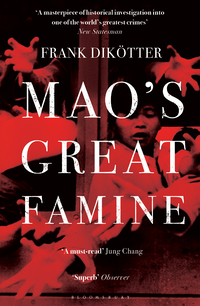The Literary Review, 3 September 2010
'Livelihood Issues'
In 1936 Mao Tse-Tung, then a cave-dwelling revolutionary, told Edgar Snow his life story. Snow recorded Mao's self-serving autobiography in Red Star Over China, which for decades made the American's name as the leading reporter in China.
Back in China twenty-four years later, Snow was pestered by news agencies enquiring about mass starvation. The Snow of the 1930s had gone into the field to see for himself a prolonged drought in the north-west, where people were rumoured to be selling their children. But this time he relied on his access to top officials such as Premier Zhou Enlai, and foreigners who flacked for China such as the New Zealander Rewi Alley. In the book he wrote about that trip, The Other Side of the River, Snow stated, 'I saw no starving people in China ... Considerable malnutrition undoubtedly existed. Mass starvation? No.' And most positively: 'Whatever he was eating, the average Chinese maintained himself in good health, as far as anyone could see.'
In brutal fact, between 1959 and 1962, at least forty-three million Chinese died during the famine Snow didn't bother to see. Most died of hunger, over two million were executed or were beaten or tortured to death, the birth rate halved in some places, parents sold their children, and people dug up the dead and ate them.
The cause of this disaster, the worst ever to befall China and one of the worst anywhere at any time, was Mao, who, cheered on by his sycophantic and frightened colleagues, decreed that before long China's economy must overtake that of the Soviet Union, Britain and even the US. Mao suggested that 'When there is not enough to eat people starve to death. It is better to let half of the people die so that the other half can eat their fill,' and declared that anyone who questioned his policies was a 'Rightist', a toxic term eventually applied to thirteen million Party members.
The outlines and many of the specifics of this catastrophe have been known in the West for decades. A few brave Chinese, too, have exposed what they discovered. Mao's doctor, Li Zhisui, wrote about it from his exile in the United States, and some revealing local studies by Americans have made clear what happened in certain villages.
Now Frank Dikötter, a professor at the School of Oriental and African Studies in London and at Hong Kong University, has laid out the vast horror in detail, drawing on local and provincial archives that have only recently become available to approved foreign scholars. In terms of Mao's reputation this book leaves the Chairman for dead, as a monster in the same league as Hitler and Stalin - and that is without considering the years of the Cultural Revolution (1966-76), when hundreds of thousands more Chinese died. One of Dikötter's observations is that Mao instigated the Cultural Revolution to wreak revenge on close colleagues who had dared to show him up. It is a mark of the historical darkness that still envelops China that many Chinese blame the famine on the Soviet Union, which, they maintain, snatched food from the mouths of starving Chinese by insisting that Beijing export grain to repay Moscow's loans.
Until recently, Dikötter states, most accounts of the famine have been based on central government sources that are often incomplete or untrue. What he found during his years rummaging in archives throughout China was that such central documents were transmitted in fuller, less censored versions to the provinces and below. In addition, the archives he saw contained letters of complaint or justification from local officials and even ordinary people, minutes from local and even central meetings, and statistics which were either falsified to hoodwink Mao or local superiors, or were subtle enough to reveal that awful things were happening. For example, in 1960 in the 'model province' of Henan, in Xinyang alone 'over a million people died ... Of these victims 67,000 were clubbed to death with sticks'. When this came to Mao 'he blamed the trouble on class enemies'. On another occasion, when the Chairman learned that there had been terrible deaths in one town he had hitherto admired, 'Mao simply switched his allegiance to the next county down the road willing to outdo others in extravagant production claims.' Mao and his cronies insisted, as one of them put it as reports of deaths rolled in, that 'This is the price we have to pay; it's nothing to be afraid of. Who knows how many people have been sacrificed on the battlefields and in the prisons [for the revolutionary cause]? Now we have a few cases of illness and death; it's nothing!' Every detail was locally recorded and explained - or obscured. Take this report from 25 February 1960 in Yaohejia village: 'Name of culprit: Yang Zhongsheng ... Name of victim: Yang Ecshun. Relationship with Culprit: Younger Brother ... Manner of Crime: Killed and Eaten. Reason: Livelihood Issues.'
Society completely unravelled. In the newly established communes, peasants following Mao's lunatic advice ploughed their paddies uselessly deep. They dismantled their houses to use as fertiliser, and melted down their tools to make the steel Mao had decreed was the mark of an advanced socialist country (after all wasn't Stalin 'the man of steel'?). Other peasants abandoned their fields and marched miles to work all night constructing mammoth water schemes that often came to nothing, while their families died without grain at home. The only reason millions more didn't starve, as Dikötter describes in detail, is because of their desperate ploys to steal food.
Dikötter is very sure of himself and sometimes scornful. He dismisses the reports of the 'fabled sinologists in the British embassy [as] pretty clueless' without showing why. He says that only one foreign scholar, Jasper Becker, author in 1996 of the 'very readable' Hungry Ghosts: Mao's Secret Famine, discovered that in 1979, after Mao's death in 1976, a team surveying rural China concluded that forty-three to forty-six million people died during the famine. This is the figure adopted, minimally, by Dikötter. But the same source and number appeared in 1997 in volume three of Roderick MacFarquhar's The Origins of the Cultural Revolution. Rightly proud of his own investigations, Dikötter doesn't make much use of revealing local studies like Ralph A Thaxton's Catastrophe and Contention in Rural China, and Edward Friedman et al's Chinese Village, Socialist State. And he is dismissive of Tombstone (which he mistranslates as Wooden Tombstone), a sweeping, very informative investigation into the famine by the courageous Chinese journalist Yang Jisheng, which of course had to be published in Hong Kong two years ago.
Never mind. Few scholars can resist a bit of contempt. This is for now the best and last word on Mao's greatest horror. Frank Dikötter has put everyone in the field of Chinese studies in his debt, together with anyone else interested in the real China. Sooner or later the Chinese, too, will praise his name.

